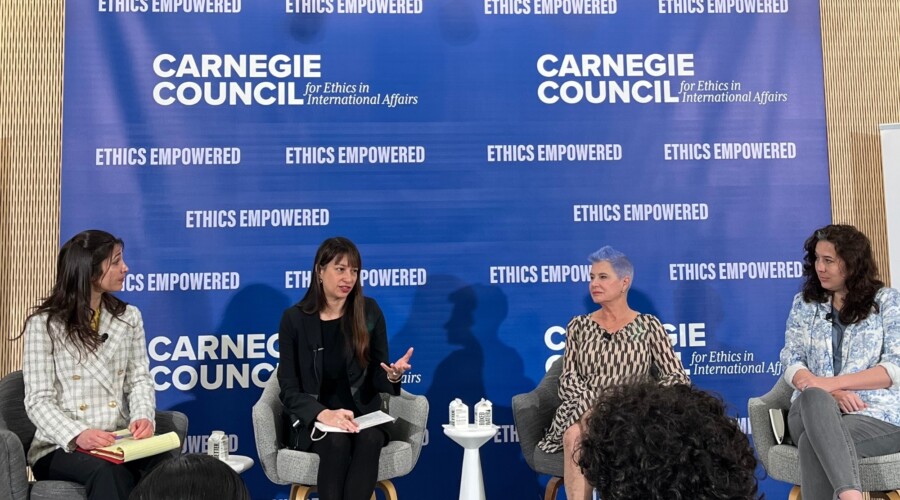David H. Shinn and Joshua Eisenman
China and Africa: A Century of Engagement
Philadelphia : University of Pennsylvania Press 2012. 544 pages
Early on in China and Africa: A Century of Engagement there is a very telling sentence: "Put bluntly, China is trying hard to increase its global economic and political power while not scaring the rest of the world, including Africa" (p. 53). This could almost be a thesis for the book, which is a comprehensive look at the relationship between the Asian giant and the world's least developed continent. Written by David Shinn, former U.S. ambassador to Ethiopia and Burkina Faso, and Joshua Eisenman, senior fellow in China studies at the American Foreign Policy Council, this volume also provides a perceptive and unbiased description of China, a global power of growing importance that is still maturing and trying to work out its role in the world at large.
Shinn and Eisenman are interested in the facts about the relationship between China and Africa. China's dealings in Africa span over 1,000 years and encompass over 50 nations, so even though the book is nearly 400 pages long, with hundreds of footnotes, and over a dozen data tables and charts, it can almost be called concise. In addition, the authors pack in a chapter with individual sections on China's relationship with every African nation, from old friends, like Egypt, Algeria, and Morocco; to emerging oil hotspots, like Equatorial Guinea and Gabon; to the states that cause hand-wringing in the U.S., like Ethiopia and Sudan. Even Swaziland, the tiny landlocked nation near the southern tip of the continent that has never had an official relationship with China, gets a page. This will be a reference book for years to come and general readers and experts alike will find plenty to keep them interested.
If there is one thing that any reader will take away from this work, it is the enormity and complexity of China's relationship with Africa. Even the terms "Africa" and "China" are not nearly as simple as they seem. For example, China's longtime friendship with Egypt has little effect on China's mining interests thousands of miles south in Zambia. The fact that both countries are on the same enormous piece of land is almost incidental. And, for some African nations, "China" actually means "Taiwan." Even today, it is all but impossible for an African country to have a diplomatic relationship with both states.
Through on-the-ground reporting and interviews, generous citations of other sources, and meticulously compiled data tables, Shinn and Eisenman let this complexity come through. They make sure to never generalize about their subject and mostly leave editorializing to others. And because of that, China and Africa brings to light many contradictions, answers numerous questions, while raising many others, and illuminates a very un-Western form of diplomacy. The book significantly demystifies a relationship that many Westerners know little about, while also acknowledging there is plenty an outsider will never know. It is this dichotomy that is at the heart of book and the relationship that it analyzes.
The book opens with a history lesson that outlines China's centuries-long involvement in Africa. Some suggest that the Chinese traders first visited Africa's east coast 1,200 years ago or even further back. There is no dispute, however, that in the 15th century, legendary explorer Zheng He reached East Africa on one of his trips through the Indian Ocean. This was the last in a series of visits from Chinese navigators to East Africa for hundreds of years, and, according to a 2008 Council on Foreign Relations report, these explorers reportedly left "no trace of their culture or genetic heritage," and treated the Africans with "courtesy and restraint" (p. 21). While there are conflicting accounts of the benevolence of these early explorers, these encounters still stand in stark contrast to how Europeans first interacted with Africans, Asians, and Native Americans.
After turning inward for several centuries, China returned to Africa in the 20th century and this time, the involvement extended to every facet of both societies, with the two entities forming political, social, economic, academic, and journalistic relationships. This is where Shinn and Eisenman begin their work in earnest. As the relationship between the two entities has grown exponentially over the last 100 years, the authors had no shortage of material to sift through. But the actual process of this sifting, as the book makes very clear, was a challenge that illuminated the differences between the Chinese and American worldviews in a very general sense.
The collection and publication of raw data, for example, is treated very differently in China as compared to America. The authors mention several times that a lot of the economic activity between the titular entities has just not been documented, or is not readily available. They write that the "largest problem" they confronted when analyzing trade between China and Africa is "lack of reliable and consistent data" (p. 99). And, they write, "Measuring China's foreign direct investment is an art rather than a science" (p. 131). This makes it hard to analyze many aspects of the relationship, though Shinn and Eisenman certainly do not let this stop them. While their tables documenting trade between China and Africa are not comprehensive, they are probably as close as anyone outside the Chinese government (or perhaps inside the Chinese government, for that matter) will get to a full picture.
Some facts are completely clear, though, even with incomplete data: Namely, China has rapidly ramped up its economic presence in the continent in recent years. In 2006, there were 800 Chinese companies in Africa; in 2009, there were 2,000; in 2011, there were 4,600 (p. 129). In 1990, China's cumulative foreign direct investment in Africa was $49 million; by the end of the 1990s, it was $820 million; in 2005, it was $1.6 billion; and in 2009, it was, officially, $9.33 billion, but, during a 2011 speech at the University of Nairobi, one Chinese government official said it was more than $30 billion (p. 132).
It is easy to see why this explosion of economic interest could scare the rest of the world and China knows this. The state government calls it the "China threat theory" (p. 374). There is no shortage of influential writers and politicians calling China's interest in Africa neo-colonialism or saying that the country is pillaging the continent for its resources. In a visit to Senegal in August 2012, Secretary of State Hillary Clinton said the U.S. was committed to "a model of sustainable partnership that adds value, rather than extracts it" from Africa. Many, including the Chinese government, took this as a criticism of China. As Shinn and Eisenman write, China is trying hard, mostly through its state-run media, to convince the world that this is not the case, while making sure their money, resources, and ideology are secure.
Up to this point, while facts from Chinese state apparatuses may be hard to come by, there is no shortage of statements, missives, white papers, and speeches explaining the benevolent nature of China's interest in Africa. Beginning with the Bandung Conference in 1955, which spawned the still-relevant "Five Principles of Peaceful Coexistence" and the "Ten Principles of Bandung," the Chinese leaders portrayed their relationship with Africa as mutually politically beneficial, built on respect for sovereignty and territorial integrity, and "mutual nonaggression" (p. 33). As the Cold War raged and European colonialism was coming to an end in many parts of Africa, China positioned itself as the alternative to Western imperialism. So when leftist ideologies became a popular choice for many of the new African states, China was happy to lend its support, which at that time was mostly political, cultural, and ideological. Financial activity between the two entities remained low and foreign direct investment to the continent only began in 1979 (p. 128). And with just $42 million worth of Chinese arms going to Africa between 1961 and 1971 (83 percent of which went to Tanzania), China ranked seventh as an arms supplier to the continent, behind Czechoslovakia (pp. 165-166).
But as "Mao's Little Red Book was replaced with a balance sheet" (p. 362) with respect to Africa in the 1990s and 2000s, the most common word in all of China's statements directed toward the continent was and is still probably "friend"—the word they also used to employ for such "sisters in socialism" as Cuba and Albania. While Westerners may roll their eyes at this, the Chinese have been using it for decades, all the way from Bandung to the 2006 white paper "China's African Policy." The relationship certainly ebbed during the Cultural Revolution, when China largely closed itself off from the world, but China always seemed to put a friendly face on its relations with Africa.
Of course, reading even just a little between the lines, one can say that "friend" is a loaded, fickle, and sometimes contradictory word when it comes to dealing with China. To be a friend, a state must first cut off diplomatic ties with Taiwan. To be an even better friend, it helps to have oil, minerals, gold, or other natural resources. A large population that is willing to work for next to nothing gets you an even better spot in the friend circle. Infrastructure deals, media relationships, and diplomatic and academic exchanges put you ever closer to this status.
The Taiwan issue is the most emblematic of this style of international friendship. Many countries have switched their diplomatic allegiances back and forth between the two, and China is always happy to have them back. It is a strictly business relationship, yet built on something personal and deeply held for the Chinese.
And this is one of the main areas of conflict with American and Western values. In the United States, friendship is not turned on and off as easily. Although it is easy to point out hypocritical stances that the United States takes with countries with questionable human rights records, like Saudi Arabia or even China, it is clear why these relationships endure. They have also been built up for decades and would not be easily forsaken. All an African country has to do to terminate its friendship with China, though, is just say that it recognizes Taiwan or that Tibet should be independent. So, through a Chinese lens "friendship" takes on a more practical and, at the same time, fanciful meaning. High-level politicians in China and Africa have certainly looked past the word and realized that it was just a euphemism for something else (mostly money and political favors), yet for decades the word keeps coming up. Even if China is selling weapons to Omar al-Bashir for the Janjaweed to use in Darfur or dealing with a country that has just spent the past five years as a favored trading partner with Taiwan, this polite gesture is always on the table as long as certain preconditions are met. To use a favorite Chinese aphorism, the country's relationship with the continent has always been based on the notion of "win-win."
Now more than ever, the world is influenced and affected by all things Chinese, especially its relationships with developing countries. There is much to learn through studying the country's dealings with Africa. This book is, therefore, an important resource for anyone concerned with international relations. If you are interested in China and/or Africa, the book illuminates two misunderstood parts of the world. And even if your interests lie elsewhere, China and Africa provides an example of how to write a comprehensive, authoritative work when the facts might be hard to come by, but the opinions and editorials are not. Shinn and Eisenman provide us with the facts and let them speak for themselves.




